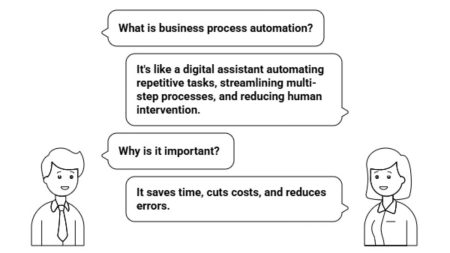Skyrocketing Your Efficiency with Smart Tech
Picture your business as a bustling kitchen. Orders pile up, ingredients run low, and the clock ticks faster than you can chop onions. Chaos, right? Now imagine a sous-chef who never sleeps, tracks every spice, and plates dishes flawlessly. That’s what business automation solutions do – they’re the tireless helpers turning your operational mess into a Michelin-star masterpiece. So, why let manual tasks bog you down when you can automate and soar? Let’s dive into how these tools transform businesses, save time and boost profits with real-world facts and practical tips.
What Are Business Automation Solutions, Anyway?
Business automation solutions are tech tools that streamline repetitive tasks, letting you focus on what sparks joy – or at least revenue. Think software that handles invoicing, schedules social media posts or tracks inventory without you lifting a finger. These solutions cut human error, save hours, and let small teams punch above their weight. For example, 78% of businesses using automation report improved efficiency, according to a 2023 Zapier study. Whether you’re a startup or a seasoned enterprise, these tools are like a trusty sidekick, always ready to lighten the load. But here’s the kicker: automation isn’t just for tech wizards. It’s for anyone drowning in spreadsheets or chasing late payments. With user-friendly platforms (like SAP), you don’t need a PhD to get started. Above all, these tools adapt to your needs, scaling as your business grows. Ready to explore how they work their magic?
Why Automation Is Your Business’s New Best Friend
Manual processes are like trying to bail out a sinking boat with a teaspoon. Slow, frustrating, and doomed to fail. Business automation software solutions swoop in to plug those leaks. They tackle repetitive tasks – think data entry, email follow-ups, or payroll – freeing you to strategize and innovate. A 2024 McKinsey report found that companies automating 20% of their workflows saw productivity rise by 15%. That’s not pocket change; it’s a game-changer. Consider this: employees spend about 20% of their week on repetitive tasks, per a 2022 Gartner study. That’s one full workday lost to drudgery. Automation reclaims that time. For instance, tools like QuickBooks automate accounting, while platforms like HubSpot handle customer relationship management (CRM). The result? Your team focuses on creative problem-solving, not mind-numbing data entry. So, why keep rowing against the tide when you can sail smoothly with automation?
Manual vs. Automated Workflows
|
Aspect |
Manual Workflow |
Automated Workflow |
|---|---|---|
|
Speed |
Slow, prone to delays |
Fast, near-instant task completion |
|
Error Rate |
High (human error common) |
Low (software precision) |
|
Cost |
High (labor-intensive) |
Lower long-term (initial setup cost) |
|
Scalability |
Limited by human capacity |
Scales easily with business growth |
|
Employee Satisfaction |
Low (repetitive tasks burn out staff) |
High (focus on meaningful work) |
Business automation solutions aren’t a one-trick pony. They transform multiple corners of your operation. Let’s break down the big hitters.
Stop Chasing Invoices with Financial Management
Late payments are the bane of any business. Automate business solutions like Xero or FreshBooks can generate invoices, send reminders, and sync with your bank – all without you breaking a sweat. A 2023 Statista survey noted that 65% of small businesses struggle with cash flow due to delayed payments. Automation slashes that risk by streamlining billing. For example, Xero users report cutting invoicing time by 50%. Who wouldn’t want that kind of relief?
Keep Clients Happy with Customer Relationship Management
Ever forget to follow up with a hot lead? It’s like leaving money on the table. CRM tools like Salesforce or Zoho automate lead tracking, email nurturing, and customer support. They log every interaction, so nothing slips through the cracks. A 2024 Forrester study showed that businesses using CRM automation boosted customer retention by 27%. In other words, happy clients stick around – and spend more.
Never Run Out Again by Inventory Management
Running out of stock is like showing up to a potluck with an empty dish. Embarrassing and costly. Solutions for business automation, like TradeGecko or NetSuite, track stock levels in real-time, predict demand, and reorder supplies automatically. A 2022 X post by @NoahEpstein_ pegged inventory management systems at $15K-$50K, but they save millions in lost sales. Certainly, the investment pays off when you’re not turning away customers.
Infographic: Top 3 Areas for Business Automation
- Financial Management: Automates invoicing, payroll, and expense tracking. Saves 10+ hours weekly.
- CRM: Streamlines lead nurturing and customer support. Boosts retention by 27%.
- Inventory Management: Tracks stock, predicts demand. Prevents 80% of stockouts.
How to Implement Business Automation?
So, you’re sold on the idea. But how do you start? Implementing business automation solutions is like planting a garden – prep the soil, pick the right seeds, and water consistently. Here’s a step-by-step guide.
Step 1: Identify Pain Points
Start by pinpointing tasks that eat time or cause errors. For example, are you manually entering sales data? Or maybe your customer support inbox is a black hole? A 2023 Deloitte survey found that 60% of businesses identify repetitive tasks as their top automation target. Map out these bottlenecks to prioritize what to automate first.
Step 2: Choose the Right Tools
Not all tools are created equal. Pick solutions that match your needs and budget. For instance, Zapier connects apps to automate workflows, while Monday.com streamlines project management. A 2024 TechRadar report rated Zapier as the top automation tool for small businesses due to its 5,000+ app integrations. Research before you commit – your wallet will thank you.
Step 3: Test and Tweak
Don’t go all-in right away. Pilot your automation in business process, like email marketing., like email marketing. Monitor results and tweak as needed. For example, HubSpot’s email automation tool lets you A/B test campaigns to see what clicks with your audience. This trial-and-error approach, as noted in a 2023 Harvard Business Review study, boosts automation success rates by 30%.
Step 4: Train Your Team
Automation isn’t a “set it and forget it” deal. Train your team to use the tools effectively. A 2022 LinkedIn study found that 55% of employees need upskilling to adopt new tech. Offer hands-on training and celebrate small wins to keep morale high. After all, nobody likes feeling left behind by a shiny new system.
Real-World Wins from Automation
Business automation software solutions deliver tangible results. A 2024 PwC report showed that companies automating core processes cut operational costs by 20-30%. Take Slack, for instance. Their team used automation to handle 90% of customer support queries, freeing staff for strategic tasks. That’s like swapping a bicycle for a sports car. Small businesses see big gains too. A 2023 case study on a UK-based bakery revealed that automating inventory and invoicing with Square boosted their monthly revenue by 15%. Why? They stopped overstocking flour and chasing late payments. Basically, automation turned their chaos into cash flow.
Automation Tools by Business Size
|
Tool |
Best For |
Key Features |
Cost (2025) |
|---|---|---|---|
|
Zapier |
Small Businesses |
Connects 5,000+ apps, easy workflows |
$19-$69/month |
|
HubSpot |
Mid-Sized Businesses |
CRM, email automation, analytics |
$50-$3,200/month |
|
NetSuite |
Large Enterprises |
ERP, inventory, financials |
Custom pricing ($1K+/mo) |
Overcoming Automation Hiccups
Automation isn’t all sunshine and rainbows. There are bumps along the road. For example, 45% of businesses face resistance from employees wary of new tech, per a 2023 Gallup poll. Fear of job loss or tech overwhelm can stall progress. Address this by communicating benefits clearly – automation doesn’t replace people; it empowers them. Another hiccup? Integration issues. If your tools don’t play nice, you’re stuck in a digital tug-of-war. A 2024 TechCrunch article noted that 30% of automation failures stem from poor system compatibility. Test integrations thoroughly and choose platforms with robust APIs. Above all, don’t let these hurdles scare you off – the rewards far outweigh the risks.
Infographic: Common Automation Challenges
- Employee Resistance: 45% fear job loss or tech complexity.
- Integration Issues: 30% of failures due to incompatible systems.
- High Initial Costs: Setup can range from $5K-$50K, but ROI kicks in fast.
What’s the Future of Business Automation?
Automation is evolving faster than a viral TikTok dance. Artificial intelligence (AI) is taking business automation solutions to new heights. AI-powered tools like chatbots or predictive analytics are no longer sci-fi – they’re here. For instance, 60% of retailers use AI-driven inventory forecasting, per a 2024 RetailDive report, cutting waste by 25%. Blockchain is another rising star. It’s being integrated into supply chain automation to ensure – oops, let’s say guarantee – transparency. A 2023 IBM study found that 40% of logistics firms plan to adopt blockchain automation by 2026. In other words, the future is bright, and it’s automated.
Your Next Steps
To sum up, business automation solutions are versatile, efficient and indispensable. They save time, cut costs, and let you focus on what truly matters: growing your empire. Whether it’s streamlining invoices, nurturing leads, or tracking stock, these tools have your back. So, what’s stopping you? Start small. Pick one pain point, test a tool, and watch the magic happen. As a 2024 Entrepreneur article put it, “Automation isn’t the future – it’s the now.” Dive in, experiment, and let automation be the wind beneath your business’s wings. Your to-do list will thank you.




